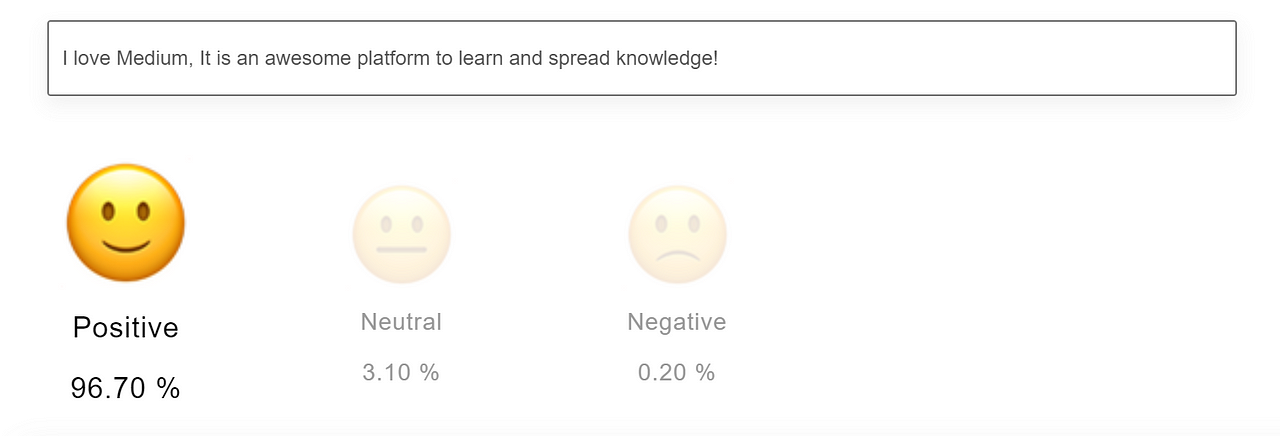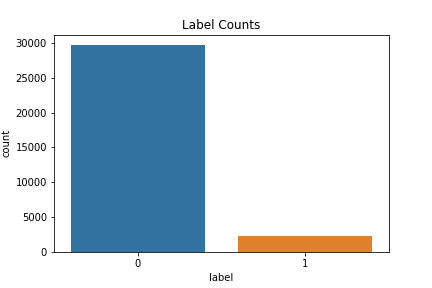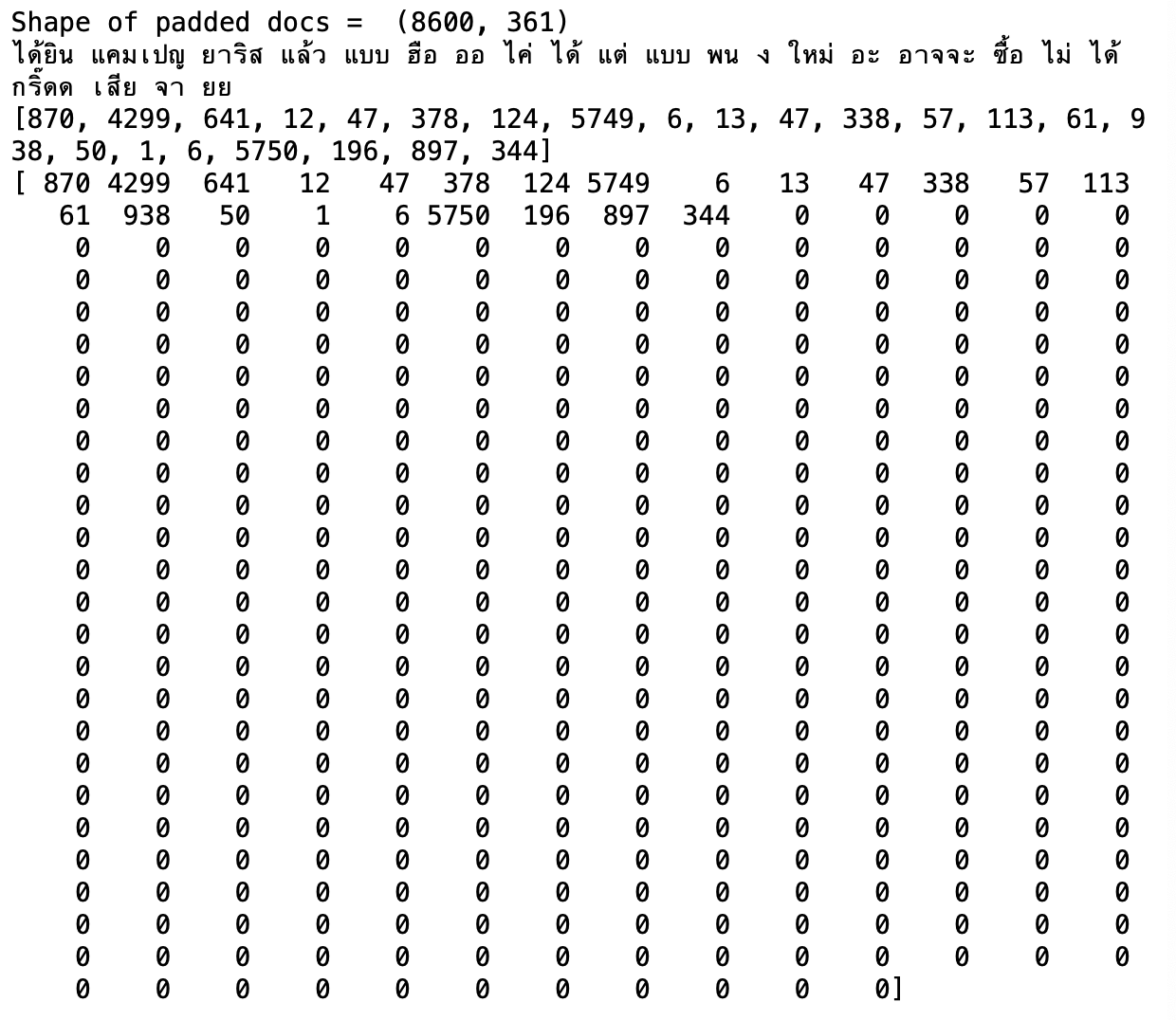45 sentiment analysis without labels
Getting Started with Sentiment Analysis using Python Training a sentiment analysis model using AutoNLP is super easy and it just takes a few clicks 🤯. Let's give it a try! As a first step, let's get some data! You'll use Sentiment140, a popular sentiment analysis dataset that consists of Twitter messages labeled with 3 sentiments: 0 (negative), 2 (neutral), and 4 (positive). The dataset is quite big; it contains 1,600,000 tweets. Where can I find datasets for sentiment analysis which don't ... - Quora Create a list of emoticons having positive sentiment and another list for negative sentiments. Then if a tweet contains only (or mostly) emoticons of positive sentiment then label it as positive tweet and vice verse for negative label. It is not necessary that you can label all the tweets in this way as every tweet does not contain emoticons.
rafaljanwojcik/Unsupervised-Sentiment-Analysis - GitHub Unsupervised-Sentiment-Analysis. How to extract sentiment from the data without any labels. Repo for towardsdatascience article: about Unsupervised Sentiment Analysis on Polish Sentiment Dataset. Analyzed dataset comes from wonderful article by Szymon Płotka: .

Sentiment analysis without labels
Is it possible to do sentiment analysis of unlabelled text using ... Essentially, no - you can't perform sentiment analysis without some labeled data. Without labels, of some sort, you have no way of evaluating whether you're getting anything right. So, you could just use this sentiment-analysis function: get_sentiment(text): return random.choice(['positive', 'negative']) Woohoo! Sentiment Analysis: First Steps With Python's NLTK Library Sentiment analysis is the practice of using algorithms to classify various samples of related text into overall positive and negative categories. With NLTK, you can employ these algorithms through powerful built-in machine learning operations to obtain insights from linguistic data. Remove ads Installing and Importing 15 of The Best Sentiment Analysis Tools - MonkeyLearn Blog This online tool runs aspect-based sentiment analysis to decide whether specific topics are mentioned in a positive, negative, or neutral way. Additionally, you can define a dictionary to include any specific vocabulary that you might use in your field.
Sentiment analysis without labels. Sentiment Analysis in Python: TextBlob vs Vader Sentiment vs Flair vs ... Sentiment analysis is the task of determining the emotional value of a given expression in natural language. It is essentially a multiclass text classification text where the given input text is classified into positive, neutral, or negative sentiment. The number of classes can vary according to the nature of the training dataset. Sentiment Analysis | Comprehensive Beginners Guide - Thematic Sentiment analysis is used to determine whether a given text contains negative, positive, or neutral emotions. It's a form of text analytics that uses natural language processing (NLP) and machine learning. Sentiment analysis is also known as "opinion mining" or "emotion artificial intelligence". Sentiment Scoring Unsupervised Sentiment Analysis | Data Science and Machine ... - Kaggle Unsupervised Sentiment Analysis. Sentiment analysis refers to the use of natural language processing, text analysis, computational linguistics, and many more to identify and quantify the sentiment of some kind of text or audio. Often, you may not have the convenience of a well-labeled training dataset. In those situations, you need to use ... Evaluating Unsupervised Sentiment Analysis Tools Using Labeled Data Sentiment analysis also exists in unsupervised learning, where tools/libraries are used to classify opinions with no cheatsheet, or already labeled output. This makes it somewhat hard to evaluate these tools, as there aren't any pre-prepared answers. Therefore, deciding what tool or model to use to analyze the sentiment of unlabeled text data ...
How to Do Twitter Sentiment Analysis Without Breaking a Sweat? Sentiment Analysis (also known as Emotion AI) is the process of measuring the tone of writing and evaluating whether it is positive, neutral, or negative. Sentiment analysis is based on solutions developed in the field of natural language processing (NLP). Free Online Sentiment Analysis Tool - MonkeyLearn Sentiment analysis benefits: 👍. Quickly detect negative comments & respond instantly. 👍. Improve response times to urgent queries by 65%. 👍. Take on 20% higher data volume. 👍. Monitor sentiment about your brand, product, or service in real time. How to Succeed in Multilingual Sentiment Analysis without ... - Medium You can follow the proposed process of sentiment analysis in the figure below. First, we preprocess our texts in a foreign language (remove urls, emojis, digits and punctuation marks) and translate... How to label text for sentiment analysis — good practices If you are working on sentiment analysis problems, be careful about text labelling. If you have never labelled text in your life, this is a good exercise to do. If you only rely on clean/processed text to learn, you can face a problem where the problem is not your model, but the information that you are using to train it. 5
How to label huge Twitter data set for training a sentiment analysis ... Performing sentiment analysis on Twitter data involves five steps: Gather relevant Twitter data Clean your data using pre-processing techniques Create a sentiment analysis machine learning model Analyze your Twitter data using your sentiment analysis model Visualize the results of your Twitter sentiment analysis Prepare Your Data Tutorial: Fine-tuning BERT for Sentiment Analysis - by Skim AI By adding a simple one-hidden-layer neural network classifier on top of BERT and fine-tuning BERT, we can achieve near state-of-the-art performance, which is 10 points better than the baseline method although we only have 3,400 data points. In addition, although BERT is very large, complicated, and have millions of parameters, we only need to ... Sentiment analysis on big sparse data streams with limited labels Sentiment analysis is an important task in order to gain insights over the huge amounts of opinionated texts generated on a daily basis in social media like Twitter. Despite its huge amount, standard supervised learning methods won't work upon such sort of data due to lack of labels and the impracticality of (human) labeling at this scale. Top 12 Free Sentiment Analysis Datasets | Classified & Labeled Finding The Right Sentiment Analysis API. Repustate's sentiment analysis platform has been trained on sentiment analysis datasets in multiple industries. The engine processes millions of reviews per day for hundreds of clients across the globe. It enables real-time social media sentiment analysis and does so in 23 languages, natively. It provides topic-driven and aspect-based sentiment analysis and has a processing speed is 1,000 reviews per second.
Sentiment Analysis with VADER- Label the Unlabelled Data VADER is a lexicon and rule-based sentiment analysis tool. It is used to analyze the sentiment of a text. Lexicon is a list of lexical features (words) that are labeled with positive or negative...
How to label sentiment using NLP? - Data Science Stack Exchange Simplest Approach - Use textblob to find polarity and add the polarity of all sentences. If the overall polarity of tweet is greater than 0 , then it's positive and if less than zero , you can label it as negative. Use of lexicons- One can use MQPA lexicon , to find the presence of negative and positive words and similarly , you can compute the ...
Unsupervised Sentiment Analysis. How to extract sentiment from the data ... O ne of the common applications of NLP methods is sentiment analysis, where you try to extract from the data information about the emotions of the writer. Mainly, at least at the beginning, you would try to distinguish between positive and negative sentiment, eventually also neutral, or even retrieve score associated with a given opinion based only on text.
How to perform sentiment analysis and opinion mining - Azure Cognitive ... You can also make example requests using Language Studio without needing to write code. Sentiment Analysis. Sentiment Analysis applies sentiment labels to text, which are returned at a sentence and document level, with a confidence score for each. ... Sentiment analysis returns a sentiment label and confidence score for the entire document, and ...
Sentiment Analysis for AI by LabelMe Sentiment analysis is needed to improve moderation algorithms, learning users' attitudes towards different topics, social mood index, and study the portrait of the target audience. LabelMe has extensive experience in parsing and marking the sentiment of texts from a variety of platforms: VKontakte, YouTube, Instagram, Twitter, IQBuzz, Facebook.
Sentiment Analysis: What is it and how does it work? - Awario Sentiment analysis is an important part of monitoring your brand and assessing brand health.In your social media monitoring dashboard, keep an eye on the ratio of positive and negative mentions within the conversations about your brand and look into the key themes within both positive and negative feedback to learn what your customers tend to praise and complain about the most.
Sentiment Analysis using Python [with source code] Steps to build Sentiment Analysis Text Classifier in Python 1. Data Preprocessing As we are dealing with the text data, we need to preprocess it using word embeddings. Let's see what our data looks like. import pandas as pd df = pd.read_csv("./DesktopDataFlair/Sentiment-Analysis/Tweets.csv") We only need the text and sentiment column.
Add Labels to a Dataset for Sentiment Analysis To add labels to unlabeled data for sentiment analysis, we can use the Vader sentiment model which is one of the best approaches for sentiment analysis. We can access it using the NLTK library in Python. Let's import the necessary Python libraries and an unlabeled dataset that we need for the task of adding labels to a data for sentiment analysis:
Is it possible to do Sentiment Analysis on unlabeled data ... - Medium 1) Use the convert_label () function to change the labels from the "positive/negative" string to "1/0" integers. It is a necessary step for feeding the labels to a model. 2) Split the data into...
How do I create accurate labels for sentiment classification on ... 1) Regression Approach. Since your original data is continuous range of values, you can train a regression model that predict the polarity and than using this trained model you can label your unlabeled dataset. 2) Sentiment Classification. Since after post processing you were able to assign a unique category to each sentiment.
15 of The Best Sentiment Analysis Tools - MonkeyLearn Blog This online tool runs aspect-based sentiment analysis to decide whether specific topics are mentioned in a positive, negative, or neutral way. Additionally, you can define a dictionary to include any specific vocabulary that you might use in your field.

Targeted Sentiment analysis vs Traditional Sentiment analysis | by z_ai | Towards Data Science
Sentiment Analysis: First Steps With Python's NLTK Library Sentiment analysis is the practice of using algorithms to classify various samples of related text into overall positive and negative categories. With NLTK, you can employ these algorithms through powerful built-in machine learning operations to obtain insights from linguistic data. Remove ads Installing and Importing

Targeted Sentiment analysis vs Traditional Sentiment analysis | by z_ai | Towards Data Science
Is it possible to do sentiment analysis of unlabelled text using ... Essentially, no - you can't perform sentiment analysis without some labeled data. Without labels, of some sort, you have no way of evaluating whether you're getting anything right. So, you could just use this sentiment-analysis function: get_sentiment(text): return random.choice(['positive', 'negative']) Woohoo!













Post a Comment for "45 sentiment analysis without labels"